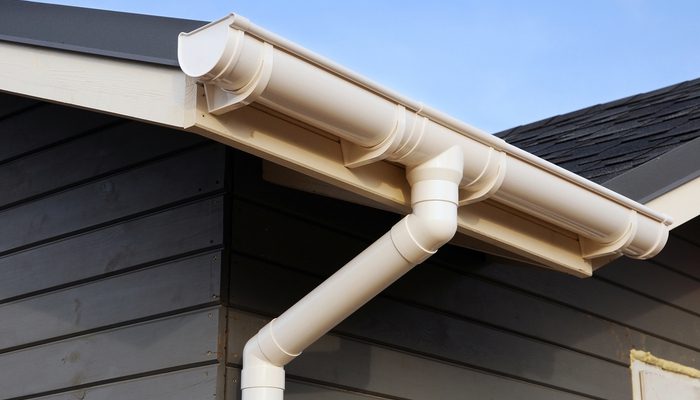Home Improvement
The Complete Guide to Gutter Systems: Protecting Your Home from Water Damage
Published
2 months agoon
By
Prime Star
Gutter systems are a crucial but often overlooked component of home maintenance. Properly functioning gutters protect your home from water damage by directing rainwater away from the foundation, siding, and landscaping. Without effective gutters, water can pool near your home, leading to costly repairs such as foundation cracks, basement flooding, and wood rot.
In this comprehensive guide, we’ll explore the different types of gutter systems, their components, installation and maintenance tips, and the benefits they provide to homeowners. Whether you’re building a new home or upgrading an old system, understanding gutters can save you time and money in the long run.
Why Are Gutter Systems Important?
Gutters are designed to channel rainwater from the roof to the ground, preventing water from dripping down walls or pooling around the home’s base. This function is critical because:
- Foundation Protection: Excess water around the foundation can cause soil erosion, leading to cracks and structural instability.
- Preventing Basement Flooding: Gutters redirect water away, reducing the risk of water seeping into basements and crawl spaces.
- Protecting Siding and Paint: Water running down walls can damage exterior paint and siding materials.
- Landscape Preservation: Proper drainage keeps flower beds, shrubs, and lawns from being washed away or over-saturated.
- Preventing Wood Rot and Mold: Gutters help keep wooden eaves, fascia, and soffits dry, reducing the risk of rot and mold growth.
Types of Gutter Systems
There are several types of gutter systems available, each with its own advantages and best use cases:
1. K-Style Gutters
K-style gutters are the most popular type used in residential homes. They have a flat back and bottom with a decorative front that resembles crown molding. Their shape allows them to carry more water than traditional half-round gutters.
- Pros: Durable, high capacity, easy to install
- Cons: Can be prone to clogging without guards
2. Half-Round Gutters
Half-round gutters have a semi-circular profile and are often found in older or historic homes. They are aesthetically pleasing and effective at channeling water but have less capacity than K-style gutters.
- Pros: Attractive design, less prone to clogging
- Cons: Lower capacity, harder to install on modern homes
3. Box Gutters
Box gutters are built into the roof structure rather than hanging off the eaves. They are common in commercial buildings and some custom homes.
- Pros: Hidden from view, integrated with roof
- Cons: Complex installation, potential for leaks if poorly maintained
4. Seamless Gutters
Seamless gutters are made from a continuous piece of material, usually aluminum, cut to length on site. They have fewer joints, which reduces leaks.
- Pros: Fewer leaks, low maintenance
- Cons: Requires professional installation
Materials Used in Gutter Systems
Choosing the right material affects gutter durability, appearance, and cost.
- Aluminum: Lightweight, rust-resistant, and affordable. Most common choice.
- Copper: Extremely durable and attractive but expensive. Over time, develops a green patina.
- Steel: Strong and durable but prone to rust if not coated.
- Vinyl: Budget-friendly and easy to install but less durable and can become brittle in cold climates.
- Zinc: Durable and corrosion-resistant but costly and less common.
Essential Components of a Gutter System
A gutter system includes several parts working together to efficiently manage water flow:
- Gutters: Channels attached along the roof edge to catch rainwater.
- Downspouts: Vertical pipes and Utility Pipe Supply
directing water from gutters down to the ground or drainage system.
- Elbows: Angled connectors to guide water around corners.
- Gutter Guards: Screens or covers to prevent leaves and debris from clogging gutters.
- Splash Blocks/Drainage Extensions: Help direct water away from the foundation at the downspout outlet.
Installation Considerations for Gutter Systems
Proper installation is vital for a gutter system to function correctly:
- Slope: Gutters need a slight slope (about 1/4 inch per 10 feet) to ensure water flows toward downspouts.
- Positioning: Gutters should be installed flush with the roof edge but allow space for debris removal.
- Downspout Placement: Downspouts should be strategically placed to direct water away from the foundation and avoid pooling.
- Sealing Joints: Seams and joints must be sealed to prevent leaks, especially in sectional gutters.
Many homeowners choose professional installation, especially for seamless gutters or complex roofing structures.
Maintenance Tips for Gutter Systems
Regular maintenance ensures your gutters function properly and extend their lifespan:
- Clean Gutters Twice a Year: Remove leaves, twigs, and debris to prevent clogs. Fall and spring are ideal times.
- Check for Leaks and Seams: Inspect for holes or gaps and seal them promptly.
- Ensure Proper Downspout Drainage: Clear blockages and ensure water is directed well away from the house.
- Inspect for Sagging or Loose Gutters: Tighten hangers and brackets as needed.
- Consider Gutter Guards: Install guards to reduce debris accumulation and maintenance frequency.
Benefits of Upgrading or Installing a Gutter System
- Prevent Costly Repairs: Gutters protect your foundation, basement, and landscaping, saving you from expensive water damage repairs.
- Increase Home Value: Well-maintained gutter systems improve curb appeal and demonstrate proper home care.
- Enhance Safety: Proper water drainage prevents ice buildup on walkways in winter, reducing slip hazards.
- Preserve Landscaping: Gutters prevent soil erosion and protect plants from excessive water exposure.
Common Problems and Solutions
- Clogged Gutters: Use gutter guards or clean regularly to prevent.
- Leaking Seams: Apply sealant or replace worn sections.
- Sagging Gutters: Reinforce with additional hangers or brackets.
- Improper Slope: Adjust installation to ensure correct pitch.
- Ice Dams: In colder climates, heated cables or improved attic insulation can reduce ice buildup.
When to Replace Your Gutter System
Signs your gutter system may need replacement include:
- Persistent leaks despite repairs
- Rust or corrosion on metal gutters
- Cracks, splits, or warping in vinyl gutters
- Frequent clogging and overflow
- Visible damage or sagging gutters
Modern materials like aluminum and copper can last decades, but age and wear may warrant an upgrade.
Conclusion
A reliable Gutter Systems,in Westchester County,NY is essential to protect your home from water damage, preserve its structure, and maintain curb appeal. Whether you choose K-style aluminum gutters for affordability or copper gutters for durability and style, understanding your options helps you make an informed decision.
Proper installation and routine maintenance ensure your gutters work efficiently year-round. Don’t overlook this vital home feature—investing in a quality gutter system safeguards your home today and into the future.

Data Privacy and Confidentiality in Legal AI: Keeping Sensitive Matters Secure

Jodi Faeth: What Happened to Mike Wolfe’s Ex-Wife After Divorce?

How GEO Helps Startups Compete With Enterprise-Level AI Visibility

Who Is Cassandra Marino? Caitlyn Jenner’s Daughter Who Lives a Private Life

Get to Know Nathan Andersen: A. J. Cook’s Husband and Proud Family Man

From Digital to Tangible: The Human Impact of Cryptocurrency to Fiat Adoption

The Real Story of Melissa Meeks, Jeremy Meeks’ Famous Ex-Wife

MegaCustom: Personal Gifts Made Beautiful

Design Something Special with MegaCustom

Top 10 SEO Agencies for Barber Shops

Who Is Marlene Knaus? The Untold Story of Niki Lauda’s First Wife

Curious About JOI Database? Read This First Before You Click Anything

Jacqueline Bernice Mitchell: The Inspiring Story of Jerry Rice’s Ex-Wife

Should You Use Wooflix in 2025? Honest Review and Best Alternatives

Where Is Noelle Watters Now? Jesse Watters’ Ex-Wife’s Life After Divorce

Where Is Barbara Boothe Now? Inside Her Life After Larry Ellison

Alisande Ullman Today: What Happened After Her Divorce from Leslie Nielsen?

Where Is Tanya Hijazi Now?: All About Rick James’ Former Wife

Wendy Lang: Meet the Therapist Married to Cenk Uygur

Mickey Middleton: The Untold Story of Bryan Cranston’s First Wife

Data Privacy and Confidentiality in Legal AI: Keeping Sensitive Matters Secure

Jodi Faeth: What Happened to Mike Wolfe’s Ex-Wife After Divorce?

How GEO Helps Startups Compete With Enterprise-Level AI Visibility

Who Is Cassandra Marino? Caitlyn Jenner’s Daughter Who Lives a Private Life

Get to Know Nathan Andersen: A. J. Cook’s Husband and Proud Family Man

From Digital to Tangible: The Human Impact of Cryptocurrency to Fiat Adoption

The Real Story of Melissa Meeks, Jeremy Meeks’ Famous Ex-Wife

MegaCustom: Personal Gifts Made Beautiful

Design Something Special with MegaCustom

Top 10 SEO Agencies for Barber Shops
Categories
Trending
-

 Celebrity6 months ago
Celebrity6 months agoWho Is Marlene Knaus? The Untold Story of Niki Lauda’s First Wife
-

 Entertainment5 months ago
Entertainment5 months agoCurious About JOI Database? Read This First Before You Click Anything
-

 Celebrity3 months ago
Celebrity3 months agoJacqueline Bernice Mitchell: The Inspiring Story of Jerry Rice’s Ex-Wife
-

 Entertainment5 months ago
Entertainment5 months agoShould You Use Wooflix in 2025? Honest Review and Best Alternatives
